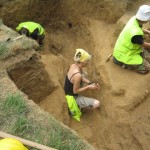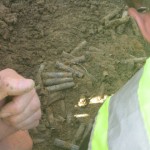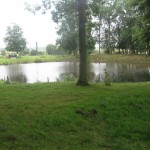My Summer Holidays by Billy Quinn aged 41 and a half.
Following a recent excursion to Belgium to investigate German trench positions in the vicinity of the the village of Messines, Declan asked if I would post an entry describing my experiences …here it is.
The excavations were directed by Martin Brown and Richard Osgood, two archaeologists working with the Defence estates in England. Both are involved with No Man’s Land – a European Group for Great War Archaeology that has been working on a seasonal basis in the area of Ploegstreet (Conmines and –Warneton), Belgium. They and their team of specialists, conservators, archaeologists and volunteers have been forensically investigating WW1 positions for the past number of years and have recently published a book “Digging Up Plugstreet” recording their findings. Youo can find lots more details on their blog here.
Work this year was concentrated on excavating a number of trenches in the vicinity of the Ultimo crater, the result of one of 19 mines that exploded beneath the German lines between 0300 and 0335 in the early morning of June 7th 1917. It is thought the mines killed in excess of 10,000 Germans and the sound of the successive detonations was heard as far away as London and Dublin. The explosions coincided with the front line troops being relieved so the large number of casualties can be accounted for by both sets of soldiers being caught up in the blast. Of the dead who were not immediately obliterated many were found with no evidence of direct trauma injuries, they were simply killed by the intensity of shock wave.
Following the explosions, the allies advanced on the Messines salient from three sides and secured their first objectives within hours. In the bloody litany of allied offensive failures the battle of Messines was a total success aided by the shock and devastation of the mines, a creeping artillery barrage, and a rapid ANZAC led advance.
To famously quote General Plumer on the night before the attack, “Gentlemen, we may not make history tomorrow, but we shall certainly change the geography.” And change it they did – today the ultimo crater is approximately 70ft wide and occupies a low ridge surrounded by a small copse of trees. It is now home to ducks and wading birds, its present pastoral setting at complete odds with its violent origins.
The excavation team was quartered in the Messines Peace Village hostel for the week and our working day began at 8.30am. Work officially finished at 5.30 but such was the crew’s enthusiasm that we rarely left the site earlier than 6pm. I’m glad to report that throughout the week we enjoyed excellent weather.
A total of 6 trenches were exposed, all with particular research objectives informed by previous excavations or more recent geophysical results. I, along with a team of 5 others under the supervision of the capable Avril, was despatched to dig a communications trench that zigzagged from a rear position to the front line. What struck me most was the extent of the upcast from the explosion. Thousands of tonnes of earth erupted into the air and the resulting infill preserved much of what wasn’t destroyed in the initial blast. Equally interesting was the sheer frequency of ferric litter. Iron fragments, shrapnel balls, driving bands from shells etc were evident in every shovel full. We found Mauser rounds spent and unspent, German stick grenades, and occasional Lee Enfield casings. As we dug down we exposed the cut of the German communication trench, defined not by any revetment but silt from puddling at the base as well as post holes and the faint ghost marks of duckboards. Running along the edge of the trench we also found communication cables and the possible remains of an electrical junction box. Elsewhere other trenches exposed fire trenches with heavy corrugate, a German concrete bunker, and a midden with some truly remarkable finds (I’m not going to steal the excavators thunder in describing them, but you can check out the Plugstreet blog for more details).
-

-
Excavations in progress in communications trench
-

-
Sandbag filled with spent cartridges
-

-
Ultimo Crater today
All in all the excavation produced a wealth of material and adds to the existing military narrative of the period. On a personal note I want to thank all of those involved for the kindness and friendliness I experienced in the nightly gatherings over a few beers in the peace park; and particularly to Martin and Richard who ran the project with such a light touch belying their thoroughly professional manner.
This entry was posted on Tuesday, August 18th, 2009 at 2:05 pm. It is filed under About Archaeology, The Irish at War.
You can follow any responses to this entry through the RSS 2.0 feed.






That’s a great post Billy, well done on all fronts.
Nice one Billy. Great post on the Great War.
It wasn’t such a great war. The food was lousy, the trenches were always wet, and it was in France. Now the invasion of Grenada. THAT was a great war. Small island in the Caribbean. No opposition to speak of. Lovely weather. Good food. And not a french man in sight.
Top of the class, sir.
Pretty cool post. I just came by your blog and wanted to say that I have really enjoyed browsing your posts.
Any way I’ll be subscribing to your feed and I hope you post again soon!
Very interesting experiences about excavations…:)
Sounds like you had a great time! especially with the good weather!
24 July 2010.
Dear Billy QUINN, I am taking the liberty of writing to you as I have just come across the article about Private Alan James MATHER of New South Wales who died in the Battles of Messines in 1917 and the Ploegsteert Archeology battlefield project did the ceremony and transfer of his remnants. My father was a WW1 soldier in the Royal Artiller and had not finished his service in 1918 and was put on the taskforce to help create the cemeteries in the Ypres region and married a local girl.Thus like most of the British children in the 20/30′s in rebuilt Yptes we went to the ETON MEMORIAL SCHOOL (later renamed the BRITISH MEMORIAL SCHOOL) which is now the Church Hall next to St George’s Memorial Church.The War Graves Commission realising since 1939 and the declaration of war that an escape programme was necessary for the women and children and the fathers (on their IWGC bicycles) and thus our Exocus started on 18th May 1940 until the 23rd May when we walked, and spent nights in farms, a Convent, empty school buildings,among the thousands of fleeing refugees clogging the roads.My parents and us family spent the war years in N.London, and returned to Ypres in February 1946 where instead of working in the Ypres region he was assigned to Ploegsteert/Le Bizet and I was sent to a Belgian school in Ypres where I did my studies in Dutch, spoke French with my mother’s family and English at home. During my summer school holidays I often cycled to see my father in his various cemeteries and took him refreshments to the Monument in Ploegsteert.In 2000 I decided to try and trace the lost children of the 1930′s British Memorial School but there were no longer any records. The London Sunday Times Magazine of April 2001 sent a journalist to Paris where I live, and interviewed me about the exodus and tracing what happened to the IWGC men and sons who were captured and taken to camps in Germany and Upper Silessia and from there commenced my long 10 years task of telling about the abandoned IWGC men and sons, or others captured, and many in the Forces fighting.Among them was a Danny QUINN (a very good friend) who came to our pre war school and at age 15 in 1934 volunteerd as a Pupil gardener in the IWGC where his father also worked. Danny escaped with us in 1940 and served in the RAF during the war on Bombers, it was only two years ago living in Boulogne sur Mer that he died.
Our story and that of Danny QUINN is told in my book THE CHILDREN WHO FOUGHT HITLER published by John Murray editions in London and is now out in an inexpensive paperback form. I also helped to initiate a one hour BBC documentary film about the same topic which was initially shown on BBC 4 on 8th and 11th November last year.
Danny Quinn spent his life in the War Graves Commission caring for cemeteries in N.Africa, the Middle East, Belgium/France, and Italy.
I am now 75 years old, feeling rather tired after 10 years of research as to what happened to the IWGC men and their families both in Belgium and N.France and the Somme region, where many were captured and taken to German camps.
My warmest regards and thank you for helping with the archaeology research in Flanders.
Thanks for the comment James.
Billy is away on ‘real’ holidays at the moment but I’m sure he’ll be very interested to read your story. Thats a fascinating part of the story of WWI that I personally wasn’t aware of. Is there anywhere online that we might be able to view the documentary?
Declan